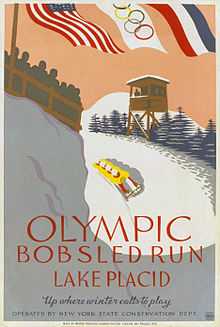Mt. Van Hoevenberg Olympic Bobsled Run
|
Mt. Van Hoevenberg Olympic Bobsled Run | |
|
| |
|
2005 aerial view of the current bobsleigh, luge, and skeleton track | |
 | |
| Location | 220 Bob Sled Run, vicinity of Lake Placid, New York |
|---|---|
| Coordinates | 44°13′13″N 73°55′17″W / 44.220222°N 73.921337°WCoordinates: 44°13′13″N 73°55′17″W / 44.220222°N 73.921337°W |
| Area | 23 acres (9.3 ha)[1] |
| Governing body | Private |
| NRHP Reference # | 10000008[2] |
| Added to NRHP | February 4, 2010[2] |
The Mt. Van Hoevenberg Olympic Bobsled Run is a venue for bobsleigh, luge and skeleton located in Lake Placid, New York, United States. This venue was used for the 1932 and 1980 Winter Olympics and for the only winter Goodwill Games in 2000. The third and most recent version of the track was completed in 2000 with the track hosting both the first FIBT World Championships and FIL World Luge Championships done outside of Europe, doing so in 1949[3] and 1983.[4] In 2010 the bobsled track was listed on the National Register of Historic Places.
History

The bobsled track was built in 1930.[1] According to the National Park Service:
Carved out of wilderness and surrounded by forested land on all sides, the one and one-half mile long Olympic Bobsled Run was constructed in 1930 and built specifically for the 1932 Winter Olympic Games. The course was designed by Stanislaus Sentzytsky, a renowned German course designer, who designed a course that was radically different from its European counterparts. The Lake Placid course was longer, steeper, and featured a more pronounced drop in curves than European runs, which allowed for steadier driving and faster speeds than those obtained on prior bobsled events. After the American team won two gold medals and one silver in 1932, bobsledding, previously unknown in America, captivated the country’s interest, and U.S. teams dominated the sport until 1956. Although portions of the course have been retired, parts of the original Olympic Bobsled Run continue to be used for training and recreation.[5]
As Mt. Van Hoevenberg Olympic Bobsled Run, the structure was listed on the U.S. National Register of Historic Places on February 4, 2010.[2] The listing was announced as the featured listing in the National Park Service's weekly list of February 19, 2010.[6]
Prior to the 1932 Winter Olympics, bobsleigh racing took place at the steep hill where the Intervales ski jump would eventually be located.[7] The attendees were delighted by the speeds of the bobsleds though several teams crashed during the run, sending two members of one team to the hospital as a result.[7] The Intervales track only lasted one season (1929–30).[7] Led by Henry Homburger, the first track was surveyed and constructed during 1929-30 at Mount Van Hoevenberg, located in the Whiteface Mountain area though it was in spite of protests of using state-owned lands for construction of the facility for environmental reasons.[7] After construction took place during August–December 1930, the track opened for use on Christmas Day 1930. This track was 2366 meters long with 26 curves, a vertical drop of 228 meters, and an average grade of 9.6%.[7]
After the 1932 games, the first 829 meters and ten curves of the track were eliminated, shortening the track's length to 1537 meters with 16 curves, and an average grade of 9.3%.[8] In 1949, the track became the first venue outside of Europe to host the FIBT World Championships[3] though it would start with tragic results when Belgian bobsledder Max Houben was killed during a practice run off of "Shady" curve prior to the event.[9] The Belgian team withdrew as a result.
It would be another twelve years before the track hosted another world championship following safety improvements to the track.[3] By this time, track officials had established a relationship with the International Bobsleigh and Tobogganing Federation (FIBT).[10] Sergio Zardini's fatal crash at the "Zig-Zag curves" on 22 February 1966 would lead to further safety improvements.[8][11]
Following the world bobsleigh championships of 1969, 1973, and 1978, many race officials of those championships would serve on the organizing committee for the bobsleigh part of the 1980 Winter Olympics.[10] In 1978 actual construction took place during September 1978-February 1979 with the creation of a reinforced concrete, artificially refrigerated bobsleigh track.[10] The bobsleigh track was approved for competition in December 1979.[10] In fall 1977, a separate luge track for the 1980 Games, the first one in the United States, was constructed with completion in time for the test competition in February 1979. During preparations for the 1980 Games, a combined two-man bobsleigh and luge track was considered, but abandoned to high cost and the track was redesigned with permission from the International Luge Federation (FIL).[10] Following the 1980 games, both tracks hosted their respective world championships [3] in 1983.[4] The 1932 track continued to be used strictly for passenger riding after the new combined track was sanctioned.
Skeleton racing debuted during the 1990s with the bobsleigh part of the track hosting the world championships in 1997.[12] By the late 1990s, parts of both tracks were demolished to make way for a new track that was constructed for the 2000 Winter Goodwill Games that was completed in January 2000.[13] The track has been part of the Lake Placid Olympic Sports Complex since the end of the 1980 Winter Olympics as part of the Olympic Regional Development Authority (ORDA).[14][15]
Since 2006, it has hosted the Chevy Geoff Bodine Bobsled Challenge, an annual event which has NASCAR drivers take a run down the track to benefit the Bo-Dyn Bobsled Project (co-created by the former NASCAR driver and 1986 Daytona 500 winner) in use by the United States since the start of the 1994 Winter Olympics.[16] In 2009, the competition took place between NASCAR and the National Hot Rod Association (NHRA) which was won by Jeg Coughlin Jr. (NHRA) won the event.[16] The 2010 event took place at the track 8–10 January with Melanie Troxel on the NHRA becoming the first woman to competes in the event.[16]
In 2009, the track became the first to host bobsleigh, luge, and skeleton world championships in the same year in a non-Winter Olympic year (The bobsleigh, luge, and skeleton track in Park City, Utah was the first to do so for the 2002 Winter Olympics in neighboring Salt Lake City).[17]
Current track statistics
| Sport | Length (meters) | Turns | Grade |
|---|---|---|---|
| Bobsleigh and men's singles luge[18] | 1455 | 20 | 9.8% |
| Skeleton | - | 19 | 9.8% |
| Luge - women's singles and men's doubles[19] | 1130 | 17 | - |
The track names were given by John Morgan during Speed Channel's World Cup bobsleigh coverage on 30 December 2006.[17][20] Turn one is not listed. Even though luge - men's singles has their starthouse to the right of bobsleigh and skeleton start, the men's singles start in the same location as the bobsleigh and skeleton.
| Turn Number | Name | Reason named |
|---|---|---|
| 2 3 |
Cliffside | Named in honor of the original Cliffside curve because the track was located alongside a cliff. |
| 4 | Whiteface | After Whiteface Mountain in the Adirondack Mountains of New York. Luge - women's singles, men's doubles, and mixed team relay join the track at this curve. |
| 5 6 7 8 9 |
Devil's Highway | Curves (5 through 7), followed by two short, successive curves (8, 9). |
| 10 | Shady II | Named in honor of the Shady corner on the 1932 track. This curve was named because it was in the shadows even when the rest of the track was shining. |
| 11 12 13 |
Labyrinth | Three quick curves in succession. |
| 14 | Benham's bend. | After Stanley Benham (1913–70), who won the gold medal in the four-man event at the 1949 FIBT World Championships in Lake Placid. |
| 15 16 |
Chicane | Two small rolling "curves" in long straightaway before 17. An athlete on the proper line will appear to travel in a straight line between the exit of 14 and entrance of 17 as they travel through the chicane. |
| 17 18 19 |
Heart curve Trickle |
Shaped like symbolic symbol of a heart.[20] The "Trickle" name was derived from popular Wisconsin short-track automobile racer and former NASCAR driver Dick Trickle, who crashed out on both runs during the 2006 Bodine Bobsled Challenge at turns 17 and 18.[21] The finish line for skeleton is at the exit of 19. |
| 20 | Finish[20] | The end of the track before the finish line. |
| Sport | Record | Nation - athlete(s) | Date | Time (seconds) |
|---|---|---|---|---|
| Bobsleigh two-woman[22] | Start | |
December 15, 2007 | 5.54 |
| Bobsleigh two-woman[22] | Track | |
December 15, 2007 | 56.94 |
| Luge - men's singles[23] | Start | David Möller - |
February 7, 2009 | 1.712 |
| Luge - men's singles[23] | Track | Tucker West - |
December 5, 2014 | 51.002 |
| Luge - women's singles[24] | Start | Tatjana Hüfner - |
February 6, 2009 | 6.350 |
| Luge - women's singles[24] | Track | Erin Hamlin - |
February 6, 2009 | 43.985 |
| Luge - men's doubles[25] | Start | |
February 6, 2009 | 6.219 |
| Luge - men's doubles[25] | Track | |
February 6, 2009 | 43.641 |
| Men's skeleton[26] | Track | Matthew Antoine - |
March 4, 2011 | 53.68 |
| Women's skeleton[27] | Track | Marion Trott - |
February 26, 2009 | 56.23 |
Previous tracks
The only curves mentioned in the 1932 Winter Olympics official report of the 26 total are shown below:[7]
| Turn Number | Name | Reason named |
|---|---|---|
| 4 | Eyrle | - |
| 10 | Whiteface | After Whiteface Mountain of the Adirondack Mountains of New York. |
| 14 | Cliffside | Because the track was located alongside a cliff. |
| 19 | Shady Corner | The corner was in the shadows even when the rest of the track was shining. |
| 23 24 25 |
Zig-Zag | Labyrinth curve (three quick curves in succession) in the shape of an S. |
The bobsleigh track used for the 1980 Winter Olympics consisted of 16 curves that was 1557 meters long with an elevation difference of 148 meters, a maximum grade of 14.0%, and an average grade of 9.5%.[28]
The luge track used for the 1980 Winter Olympics had two different settings to the different start houses used during the competition. For the men's singles event, the track consisted of 14 curves that was 1014 meters long with an elevation difference of 95.55 meters, a maximum gradient of 30% and an average grade of 9.35%.[28] In the women's singles and men's doubles event, the track consisted of 11 curves that was 749 meters long with an elevation difference of 59 meters, a maximum grade of 30%, and an average grade of 9.35%.[28]
Championships hosted
- Winter Olympics: 1932, 1980
- FIBT World Championships: 1949, 1961, 1969, 1973, 1978, 1983,[3] 1997 (men's skeleton),[12] 2003 (Men's bobsleigh),[3] 2009, 2012[3][12]
- FIL World Luge Championships: 1983, 2009[4]
References
- ↑ 1.0 1.1 Kathleen LaFrank and Philip G. Wolf (January 2009). "National Register of Historic Places Registration: Mt. Van Hoevenberg Olympic Bobsled Run" (PDF). National Park Service. Retrieved 2010-05-16. (46 pages, with maps and 10 photos from 2007)
- ↑ 2.0 2.1 2.2 "Announcements and actions on properties for the National Register of Historic Places for February 19, 2010". Weekly Listings. National Park Service. February 19, 2010. Retrieved 2010-05-16.
- ↑ 3.0 3.1 3.2 3.3 3.4 3.5 3.6 Bobsleigh two-man world championship medalists since 1931
- ↑ 4.0 4.1 4.2 FIL World Luge Championships men's single results since 1955
- ↑ "Weekly Highlight 19 February 2010 Mt. Van Hoevenberg Olympic Bobsled Run, Essex County, New York".
- ↑ "Weekly List Actions". National Park Service. Retrieved 2010-05-16.
- ↑ 7.0 7.1 7.2 7.3 7.4 7.5 1932 Winter Olympic Games official report. pp. 30, 39-41, 50-1, 157-66.
- ↑ 8.0 8.1 Bunksplace.com information on bobsleigh history: 1890-present. - Accessed 15 January 2008.
- ↑ TIME magazine 7 March 1949 article about the Lake Placid, NY bobsleigh track that took Houbon's life - Accessed 29 July 2007.
- ↑ 10.0 10.1 10.2 10.3 10.4 1980 Winter Olympic Games official report - Volume 1. pp. 57-66. (English) & (French)
- ↑ "The Deadly Zig-Zag". TIME. 4 March 1966 - Accessed August 12, 2007.
- ↑ 12.0 12.1 12.2 FIBT men's skeleton world championships results since 1989
- ↑ List of venues on Mt. Van Hoevenberg for the 2000 Winter Goodwill Games - Accessed 16 January 2008.
- ↑ About ORDA.
- ↑ ORDA profile on Lake Placid Olympic Sports Park.
- ↑ 16.0 16.1 16.2 Bo-Dyn Bobsled Project official website
- ↑ 17.0 17.1 Whiteface.com information about the track. - accessed 3 December 2009.
- ↑ FIBT track profile
- ↑ USA Luge.org list of worldwide tracks - Click on Lake Placid, NY for more information.
- ↑ 20.0 20.1 20.2 "Lake Placid Two-man". Bobsleigh 2006-07 World Cup. 30 December 2006.
- ↑ "2008 Geoff Bodine Chevy Bobsled Challenge from Lake Placid, New York". Bobsled on Speed TV. 27 January 2008.
- ↑ 22.0 22.1 [http://www.fibt.com/index.php?id=88&tx_ttnews[pointer]=34&tx_ttnews[tt_news]=253&tx_ttnews[backPid]=171&cHash=51286e1b37 Kiriasis Sets Track Record, Wins in Lake Placid.] at the Fédération Internationale de Bobsleigh et de Tobogganing (15 December 2007 article accessed 3 December 2009.)
- ↑ 23.0 23.1 FIL World Luge Championships 2009 men's singles 7 February 2009 results. - accessed 3 December 2009.
- ↑ 24.0 24.1 FIL World Luge Championships 2009 women's singles 6 February 2009 results. - accessed 3 December 2009.
- ↑ 25.0 25.1 FIL World Luge Championships 2009 men's doubles 6 February 2009 results. - accessed 3 December 2009.
- ↑ http://bobsled.teamusa.org/news/2011/03/05/oshea-and-antoine-named-u-s-skeleton-national-champions/41254?ngb_id=23
- ↑ [http://www.fibt.com/index.php?id=88&tx_ttnews[pointer]=7&tx_ttnews[tt_news]=536&tx_ttnews[backPid]=171&cHash=a4ed65a108 Trott Sets Track Record, Takes Women's Skeleton Lead.] at the Fédération Internationale de Bobsleigh et de Tobogganing (26 February 2009 article accessed 3 December 2009.)
- ↑ 28.0 28.1 28.2 1980 Winter Olympic Games official report - Volume 2, pp. 49, 171, 177. (English), (French), & (German)
External links
| ||||||||||||||||||
| ||||||
| ||||||
| ||||||||
| |||||||||||||||||||||||||
| ||||||||||||||||||||||||||



